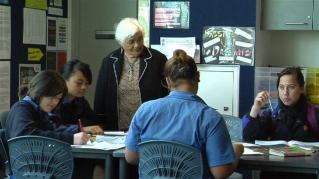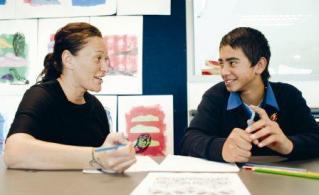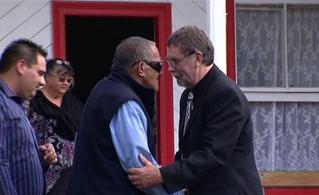Section navigation
The Taihape Area School (TAS) case studies are part of the Te Kauhua case studies report (2010), prepared for the Ministry of Education by Dr Ruth Gorinski. As part of their action research for Te Kauhua phase 3, Taihape Area School undertook two projects. For Project 2 they investigated the collaborative development of e-portfolios to engage whānau in the student learning partnership.
Research Question
The second research project that Taihape Area School (TAS) undertook focused on the collaborative development of e-portfolios to engage whānau in the student learning partnership.
Impetus for the research
The Mōkai Patea Iwi Education Forum and TAS leaders agreed to explore ways of strengthening whānau-school productive partnerships. Whilst student learning conferences had been implemented across all year groups as a step towards developing these partnerships, Iwi and TAS were eager to maximise the opportunity the conferences provided for further strengthening relationships. Together, they identified that the conveyance of quality, readily understood information to whānau through the learning conference medium, was the next stage of development. As a result, portfolios were developed and technology integrated via the implementation of ‘e-portfolios’.
What was done?
Hui were held with key stakeholders who contributed to a draft of what e-portfolios should look like at different levels across the school. Contributors, including teachers, students, and whānau were invited to comment on: how the e-portfolios should be shaped and what information they should include, what should be discussed at student learning conferences, and how best to work in partnership with whānau to strengthen learning conversations. These initial hui secured buy-in from all stakeholders who agreed to once per term student conferences using the e-portfolio as the key reporting mechanism.
A ‘meet and greet’ barbeque was organised to facilitate informal introductions amongst teachers, whānau, and students. This served as a positive starting point for building relationships prior to the more formal student conferences.
Staff attended technology training with a particular focus on e-portfolio professional development and use of Knowledge Net. Teacher quality learning teams were a useful platform for discussion and critique of the e-portfolio ‘roll out’ and for suggesting modifications to the process.
The Board of Trustees and Iwi approved the provision of computer and internet access to all TAS families. This enabled e-portfolio accessibility by all and ensured equity in terms of technology access.
Whānau co-construct learning goals with their child/ren and these are included in the e-portfolio. Teachers use Knowledge-Net to provide regular updates to whānau about their child’s progress. This facilitates student motivation and also supports whānau with strategies for supporting their child’s learning. Whānau can log on and view their child’s work and make comment via their e-portfolios.
The year 10-13 Dean and an assistant are responsible for managing the learning partnership with students and whānau at a personal level. Year 1-9 students have a home room teacher with whom they and their whānau build a relationship.
What was the impact on student learning and achievement?
- Relationships between teachers and the whānau of year 7-8 students have developed positively. “Thank you whaea for all you have done…I am happy with [my son’s] achievements at school and will try to help in any way I can…”
- For year 10-13 students, dialogue between teachers/deans, students, and whānau has become more focused on celebrating learning successes, the provision of feedback and feed forward, goal setting, and NCEA credit attainment status.
- The number of whānau attending student conferences has risen by 10% since their inception, from 65% Māori whānau attendance across years 1-9 in 2008 to 75% in 2009.
- Students across all year levels are motivated by the e-portfolio cumulative learning record and are synchronously taking increased responsibility for their learning. The celebration of learning at the whānau teacher student conference is valued and enjoyed by all participants and provides a potent impetus for ongoing goal achievement.
Key learning
- Technology literacy is a pre-requisite to e-portfolio success in building whānau-school partnerships. Prioritisation of staff technology literacy professional development is critical.
- Student data – evidence - must be readily accessible to teachers, students, and whānau.
- The purpose of each learning conference needs to be explicit to teachers, students, and whānau to enable meaningful participation.
- Students are competent to articulate their learning and celebrate their success when guided in the process. ‘Managing self’ is promoted when students are able to negotiate learning programmes that enable them to 'establish personal goals, make plans, manage projects, and set high standards' for themselves (NZC, p.12).
- Whānau can support their child’s learning by having input into their goal setting and by sharing their knowledge and expertise.
- Some scaffolding may be needed to maximise the learning opportunities of e-portfolios.
- Flexibility in terms of conference appointment times and venues is necessary to ensure optimal whānau attendance.
Challenges and opportunities
- Team leaders involved in ‘rolling out’ an initiative of this nature, need this to be their focus of responsibility to ensure traction and sustainability.
- Inconsistency of teacher’s reporting at student learning conferences can create confusion for whānau. The co-construction with whānau, of a pedagogy for e-portfolios, helps to address this.
- Teachers’ perception that preparation of e-portfolios is too time-consuming. Once they include e-portfolio development into daily planning, this challenge is alleviated.
Reflective Questions
- What should an e-portfolio contain for a year 1-13 student? Consider the different information the port-folio should contain for different year groups? Should national standards reporting be part of the e-portfolio? How might this best be done?
- What do whānau know that can contribute to their child’s e-portfolio?
- What do whānau want to know?
- What do whānau need to know?
- What does the school need to know about whānau?
- What constitutes regular communication with whānau?
- How can you best communicate with whānau? What is their preferred mode of communication?
Filed under: Productive partnerships | Effective teachers





